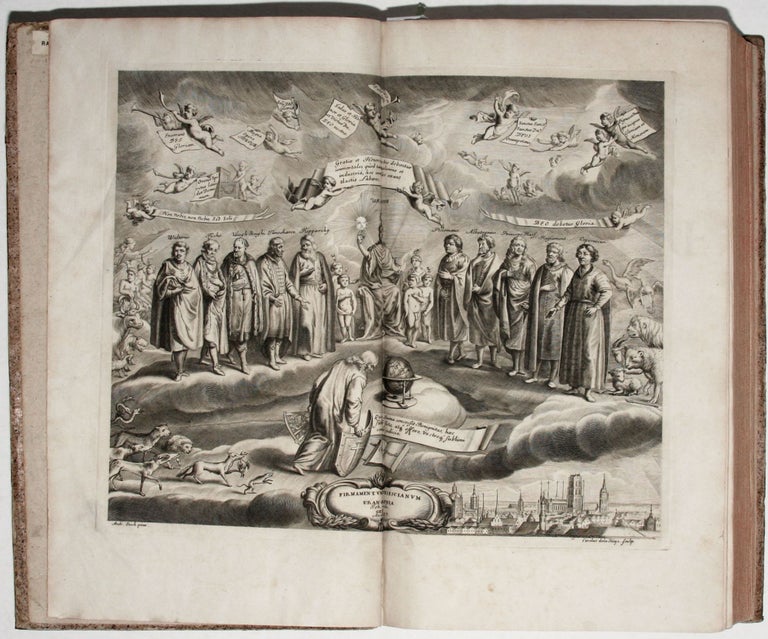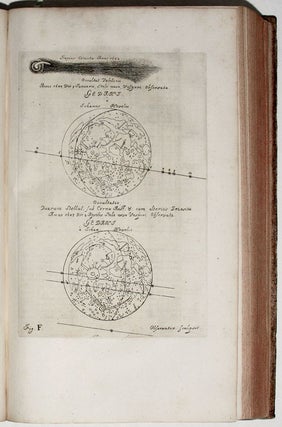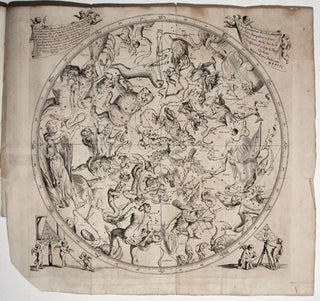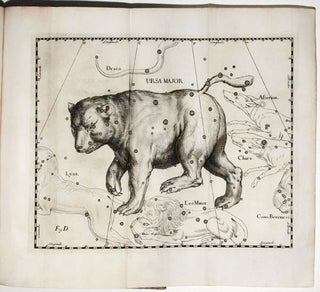Prodromus Astronomiae, exhibens fundamenta, quae tam ad novum plane & correctiorem stellarum fixarum catalogum construendum.
Folio [39.2 x 22.9 cm], (1) double-page engraved allegorical title, (10) ff. (including general half-title and title), 1 engraved author portrait (here bound at front of volume), 142 pp, single-page engraved plate A* bound opposite p. 96 as usual, engraved headpiece and initial, woodcut headpieces, tailpiece and initials. Bound 18th-century speckled pasteboards, gold stamped title label on spine, red sprinkled edges. Rubbing to spine and boards, head & tail frayed. Canceled library from the Herzoglicher S. Meiningischer Bibliothek stamp on verso of title page of Annus Climactericus, minor marginal mends to a handful of leaves, the planisphere plates a bit toned, both with a marginal repair near gutter. Generally a large and fresh copy. Excellent.
[Bound after:]
____. Johannis Hevelii Annus Climactericus, sive Rerum uranicarum observationum annus quadragesimus nonus. Danzig, Sumptibus auctoris, typis D. F. Rhetii, 1685. (6) ff., 24 pp., 196 pp., with (7) plates labeled A-G (one of which is folding), engraved device on half-title, engraved headpiece vignette, astronomical woodcuts in text, woodcut headpieces, tailpieces and initials.
[Bound with:]
____. Catalogus stellarum fixarum ex observationibus multorum annorum. Danzig, Johann Zacharias Stoll, 1687. 143-350 pp., (1) f.
[And with:]
____. Firmamentum Sobiescianum, sive Uranographia, totum coelum stellatum. Danzig, Johann Zacharias Stoll, 1690 [frontispiece dated 1687]. (1) f. title, 1 double-page engraved allegorical title dated 1687 (here bound at the front of the volume), 21 pp., (1) p. circular engraved vignette, with engraved headpiece vignette, (2) oversized folding plates of planispheres, lightly age-toned & 54 double-page engraved plates of the constellations in excellent fresh impressions.
Rare first edition of Hevelius’ star atlas, along with the Introduction (Prodromus) and the catalogue of stars, together as issued: a fundamental text in the history of astronomy and a spectacular illustrated book. The Firmamentum Sobiescianum is considered the most detailed and influential celestial atlas of its time, both in the formation of subsequent atlases and in the production of celestial globes: “Contemporary globes, such as those by G. C. Einmart, and Gerhard and Leonhard Valk, often acknowledge Hevelius as their source. Later constellation outlines and draftsmanship also owed much to the Uranographia” (North, DSB VI.364).
Warner describes Hevelius as “An outstanding astronomical observer whose private observatory in Danzig (Gdansk) was for many years the best in Europe...” His Uranographia is one of the very few star atlases actually produced by a professional working astronomer of international stature, rather than a map publisher or popularizer of astronomy (e.g., Piccolomini, Bayer, Doppelmayr, Homann, Cellarius, etc.). The Catalogus gives the precise position in the sky of each star according to specific mathematical coordinates—information essential to the practicing astronomer—and the Prodromus sets out the technology and methodology associated with producing the catalogue of fixed stars (see Brigham Young, #16). The manuscript of the Prodromus astronomiae was saved from the fire at Hevelius’ observatory in 1679—one of the few items to survive from the wide range of the texts and scientific instruments he designed.
The star atlas contains 73 constellations, of which 12 are introduced here by Hevelius himself. His discoveries include the Scutum Sobiescianum (the shield of Sobieski, i.e., the shield with which King Jan III of Poland defended Europe against the Turks, and which Hevelius so named to acknowledge the latter’s financial support); the “Lynx”, a grouping of very faint stars named because one needed the sharp eyes of this animal in order to see them; and the “Sextans”, which he called after one of the many astronomical instruments he designed. These names as well as several others coined by Hevelius are still used by astronomers today. The 57 star maps were drawn by the Polish artist Andreas Stech and engraved by Charles de la Haye, though on the basis of his known involvement in making the plates for other works, North has suggested that Hevelius had a hand in these as well.
The present volume also contains the Annus Climactericus, the last treatise Hevelius published during his lifetime and a work rarely found bound with the Firmamentum Sobiescianum. A compilation of his observational data and scientific contributions between 1679 and 1685, the Annus Climactericus is essentially a continuation of his 1679 Machinae coelestis pars posterior, with the additional notes on his collaboration with the young Edmond Halley and the latest salvo in his battle with Robert Hooke over the superior observational accuracy of open versus telescopic sights. The work contains 7 fine full-page etchings (one of which is folding) – executed by Hevelius himself – illustrating various lunar occultations and eclipses, the comets of 1680 and 1682, and the solar eclipse of 1684, as well as smaller astronomical rendering in the tables. In the preface, Hevelius' describes his observatory's conflagration which famously destroyed his instruments and many of his books and manuscripts. The ancient astrological notion of ‘climacteric years’, from which the title is taken, deals with inauspicious years occurring in multiples of 7, and Hevelius notes that the catastrophic fire happened in the forty-ninth [7 x 7] year of his career as an astronomer. He named the constellation Sextans in memory of his lost instruments.
The publication history for these works (apart from the Annus Climactericus) is somewhat unclear, as is typical with posthumous publications: Hevelius died in January of 1687, and the work was seen through the press by his widow. Two dates are associated with the Firmamentum: 1687, which appears on the handsome engraved title, and 1690, which appears on the printed title page. The title page of the Catalogus Stellarum is also dated 1687. The printed title page of the Prodromos, however, is dated 1690. This disparity in dates has led some to hypothesize that the star atlas and the Catalogue may have been issued separately for limited distribution in 1687. See the Brigham Young Catalogue, #18, which cites the Harvard copy in its defense: that copy has a frontispiece and plates but does not possess the printed title page nor text leaves. This theory is corroborated by a letter written two months after Hevelius’s death by his assistant Christoph Colbe, indicating that the star atlas was already printed, but publication was delayed until after the Catalogus went to press. It is plausible that all three titles circulated separately as early as 1687. By 1690, however, they were joined (reference is made to “the book”). Most often the three parts circulate together.
* Johannes Hevelius and his Catalogue of Stars, 55-58; J.D. North in DSB VI.360-64; Kenney, p. 83; Warner, The Sky Explored, p. 113, n. 8.
Price: $165,000.00






